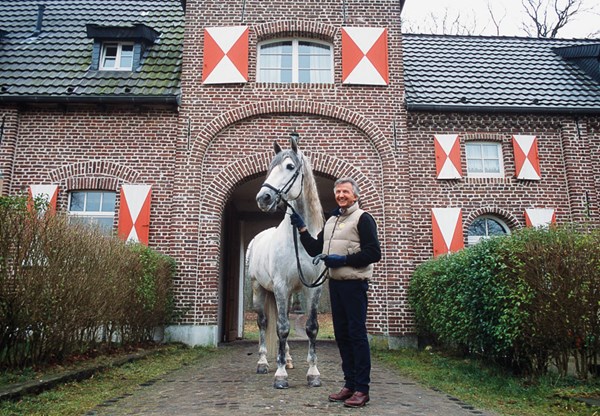
This picture shows 13-year-old Maya Tahara competing the 17-year-old Hanoverian mare, Gemma, in the All Japan Children class, where she took sixth place in the qualifying round and second place in the finals.
As I looked at the picture, the first thing I noticed was what a great connection this young rider has with her mount. Common trust and harmony, more than just technical skills, seem to be the base of their relationship. It also seems hard to believe that this mare is 17 years old. Gemma looks full of energy and willing to give her best for her rider at any time. I particularly like how she pricks her ears and seems to look forward to whatever challenge is coming next.
The next thought crossing my mind is how lucky Maya is to have such a schoolmaster to learn from! Gemma looks like fun to ride and is just the right horse to introduce her to the joy of dressage. The picture shows power and lightness of movement, but it is in such a way that Maya can control and experience it without being too overwhelmed. I can see in this picture that Maya is still lacking some experience but the horse seems to make up for this, and I get the impression that Gemma is enjoying helping her.
The lengthening of the strides performed in this picture shows good activity in a correct frame with the nose slightly in front of the vertical. Maya has already developed a nice deep seat and looks very focused in her test. However, I do notice that her leg position is slightly too far back—the inside leg should be more forward at the girth. Maya has a tendency to lean back in her shoulders and it gives me the impression that she is holding on to the reins to rebalance her upper body and find more stability. But she shows a considerable amount of feel as she does find a good balance between her weight and how much she uses the rein to help her balance. Maya now needs to learn how giving can help to stabilize and deepen her seat so that she will dare to let go and allow Gemma to shine even more.
To feel this, I often tell riders to try this: Sit on a stool in front of a desk or table with your feet close to the chair. Place your hands on the table, imagining that they are glued to the surface. Push your hands away from you and feel how your abdominal muscles automatically become engaged and your weight shifts back down onto your seat bones. At the same time your feet are often lighter on the ground. Conversely, changing the action of the hands by pulling instead of pushing activates totally different muscles inside the body. If you pull, you can feel more muscles around your shoulders and your feet often want to pull back. To learn how pushing your hands forward can activate your core is an important feeling in dressage, especially during half halts and extensions.
My advice for Maya based on this picture would be to challenge herself to change the nature of her hands from pulling or holding to pushing. By doing that, her leg position may change, too, and Gemma will be sure to reward her.
Maya and Gemma are a very promising pair. I wish both of them many more rides that teach Maya the secrets of creating harmony and beauty within the performance.
Susanne von Dietze is a leader in equestrian biomechanics. A physiotherapist, licensed Trainer A instructor and judge for dressage and show jumping, she gives lectures and seminars throughout the world. A native of Germany, she now lives in Israel, where she competes at the international level. She is the author of two books: Balance in Movement and Horse and Rider, Back to Back. Find her books at www.EquineNetworkStore.com.











